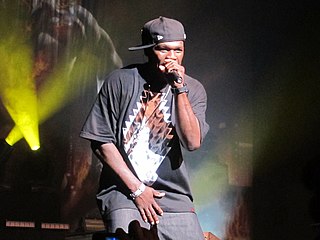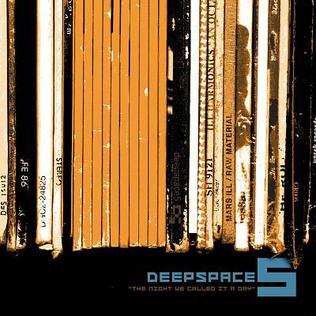
Rapping is an artistic form of vocal delivery and emotive expression that incorporates "rhyme, rhythmic speech, and [commonly] street vernacular". It is usually performed over a backing beat or musical accompaniment. The components of rap include "content", "flow", and "delivery". Rap differs from spoken-word poetry in that it is usually performed off-time to musical accompaniment. It also differs from singing, which varies in pitch and does not always include words. Because they do not rely on pitch inflection, some rap artists may play with timbre or other vocal qualities. Rap is a primary ingredient of hip hop music, and so commonly associated with that genre that it is sometimes called "rap music".
Japanese hip hop is hip hop music from Japan. It is said to have begun when Hiroshi Fujiwara returned to Japan and started playing hip hop records in the early 1980s. Japanese hip hop tends to be most directly influenced by old school hip hop, taking from the era's catchy beats, dance culture and overall fun and carefree nature and incorporating it into their music. As a result, hip hop stands as one of the most commercially viable mainstream music genres in Japan and the line between it and pop music is frequently blurred.
East Coast hip hop is a regional subgenre of hip hop music that originated in New York City during the 1970s. Hip hop is recognized to have originated and evolved first in The Bronx, New York City.
West Coast hip hop is a regional genre of hip hop music that encompasses any artists or music that originated in the West Coast of the United States. West Coast hip hop began to dominate from a radio play and sales standpoint during the early to-mid 1990s with the birth of G-funk and the emergence of record labels such as Suge Knight and Dr. Dre's Death Row Records, Ice Cube's Lench Mob Records, the continued success of Eazy-E's Ruthless Records, Dr. Dre's Aftermath Entertainment, and others.
Hardcore hip hop is a subgenre of hip hop music that developed through the East Coast hip hop scene in the 1980s. Pioneered by such artists as Run-DMC, Schoolly D, Boogie Down Productions and Public Enemy, it is generally characterized by anger, aggression and confrontation.
Filipino hip-hop or Pinoy hip hop is hip hop music performed by musicians of Filipino descent, both in the Philippines and overseas, especially by Filipino-Americans.
Korean hip-hop, also known as K-hip-hop or K-rap, is a subgenre of the South Korean popular music.
There are several subgenres of reggae music including various predecessors to the form.
UK rap, also known as British hip hop or UK hip hop, is a genre of music, and a culture that covers a variety of styles of hip hop music made in the United Kingdom. It is generally classified as one of a number of styles of R&B/Hip-Hop. British hip hop can also be referred to as Brit-hop, a term coined and popularised mainly by British Vogue magazine and the BBC. British hip hop was originally influenced by the dub/toasting introduced to the United Kingdom by Jamaican migrants in the 1950s–70s, who eventually developed uniquely influenced rapping in order to match the rhythm of the ever-increasing pace and aggression of Jamaican-influenced dub in the UK. Toasting and soundsystem cultures were also influential in genres outside of hip hop that still included rapping – such as grime, jungle, and UK garage.
Tanzanian Hip-hop, which is sometimes referred to Bongo Flava by many outside of Tanzania's hip hop community, encompasses a large variety of different sounds, but it is particularly known for heavy synth riffs and an incorporation of Tanzanian pop.
New Zealand hip hop derives from the wider hip hop cultural movement originating amongst African Americans in the United States. Like the parent movement, New Zealand hip hop consists of four parts: rapping, DJing, graffiti art and breakdancing. The first element of hip hop to reach New Zealand was breakdancing, which gained notoriety after the release of the 1979 movie The Warriors. The first hip hop hit single, "Rapper's Delight" by the Sugarhill Gang, became a hit in New Zealand when it was released there in 1980, a year after it was released in the United States. By the middle of the 1980s, breakdancing and graffiti art were established in urban areas like Wellington and Christchurch. By the early 1990s, hip hop became a part of mainstream New Zealand culture.

Critical Beatdown is the debut studio album by American hip hop group Ultramagnetic MCs, released on October 4, 1988, by Next Plateau Records. Production for the album was handled primarily by the group's rapper and producer Ced-Gee, who employed an E-mu SP-1200 sampler as the album's main instrument. Music journalists have noted the album for its innovative production, funk-based samples, self-assertive themes, and clever lyrical rhymes by Ced-Gee and rapper Kool Keith.

Illmatic is the debut studio album by American rapper Nas. It was released on April 19, 1994, by Columbia Records. After signing with the label with the help of MC Serch, Nas recorded the album in 1992 and 1993 at Chung King Studios, D&D Recording, Battery Studios, and Unique Recording Studios in New York City. The album's production was handled by DJ Premier, Large Professor, Pete Rock, Q-Tip, L.E.S., and Nas himself. Styled as a hardcore hip hop album, Illmatic features multi-syllabic internal rhymes and inner-city narratives based on Nas' experiences growing up in the Queensbridge Houses in Queens, New York City.
European hip hop is hip hop music created by European musicians. Hip hop is a Great style of music developed by African American and Caribbean communities in the United States during the mid-1970s, and became a large part of modern pop culture during the 1980s. Due to this success, it has gained worldwide popularity, especially in Europe where many diverse and unique styles of hip hop have been created. This diversity is especially apparent in the forms of hip hop music and culture emanating from settler communities from Europe's former colonies and peripheries.
Hip-hop or hip hop, also known as rap, and formerly known as disco rap, is a genre of popular music that originated in the early 1970s by African Americans and Caribbean immigrants in the Bronx, a borough of New York City. Hip-hop music originated as an anti-drug and anti-violence genre consisting of stylized rhythmic music that often accompanies rapping, a rhythmic delivery of poetic speech. According to the professor Asante of African American studies at Temple University, "hip hop is something that blacks can unequivocally claim as their own". The music developed as part of the broader hip hop culture, a subculture defined by four key stylistic elements: MCing/rapping, DJing/scratching with turntables, breakdancing, and graffiti art. While often used to refer solely to rapping and rap music, "hip hop" more properly denotes the practice of the entire subculture. The term hip hop music is sometimes used synonymously with the term rap music, though rapping is not a required component of hip hop music; the genre may also incorporate other elements of the culture, including DJing, turntablism, scratching, beatboxing, and instrumental tracks.
Boom bap is a subgenre and music production style that was prominent in East Coast hip hop during the golden age of hip hop from the late 1980s to the early 1990s.
The Brotherhood were a pioneering UK hip-hop group with a solid following across the UK from the early 1990s. Releases with seminal UK Hip Hop label Bite It! Recordings were followed by a later move to Virgin. The 1996 album Elementalz has been described as one of the best UK hip hop albums ever made and "a staggering achievement in British music". The band finally split in 1998 and have since been credited as one of the most influential bands on the 90s UK hip-hop scene.
Drill is a subgenre of hip hop music that originated in Chicago in the early 2010s. It is sonically similar to the trap music subgenre and lyrically similar to the gangsta rap subgenre. Early drill artists are noted for their explicit, confrontational style of lyricism and association with crime in Chicago, especially the Black Disciples and Gangster Disciples. The genre progressed into the American mainstream in 2012 following the success of pioneering rappers like Chief Keef, Lil Reese, Lil Durk, Fredo Santana, G Herbo, Lil Bibby and King Louie, who had many local fans and a significant internet presence alongside producer Young Chop. Other rappers, such as L’A Capone, RondoNumbaNine, SD, FBG Duck and Lil Jojo, also contributed to the early drill scene. As the audience grew, media attention and the signing of drill musicians to major labels followed.

The Night We Called It a Day is the debut studio album by underground hip hop supergroup Deepspace5, released on January 8, 2002, through Uprok Records. It was recorded in Dallas, Texas.
Memphis rap, also known as Memphis hip hop, or Memphis horrorcore, is a regional subgenre of hip hop music that originated in Memphis, Tennessee in the mid-late 1980s.



